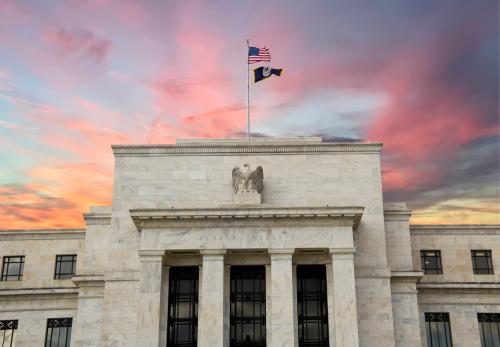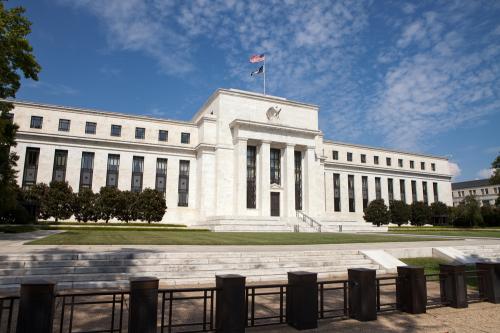Content from the Brookings-Tsinghua Public Policy Center is now archived. Since October 1, 2020, Brookings has maintained a limited partnership with Tsinghua University School of Public Policy and Management that is intended to facilitate jointly organized dialogues, meetings, and/or events.
Starting in July 2005, the RMB was de-linked from the dollar and has since been under a managed float with reference to a basket of currencies. However, from July 2005 to March 2007, the RMB appreciated only about 7%. In particular, China’s global current account surplus in 2006 jumped to a record high of $184 billion, or about 9% of GDP. As a result, China’s foreign exchange reserves have reached $1.07 trillion, the largest in the world. China has also become the second-largest holder of U.S. bonds.
The rapid rise in China’s global current account surplus and the slow appreciation of the RMB has led to a strong Washington consensus: China should be pressed hard to raise the value of its currency so as to reduce its global current account surplus as well as its current account surplus with the United States. In Congressional hearings on 28 March 2007, Institute for International Economics scholar Morris Goldstein held that China’s currency is now grossly under-valued on the order of 40 percent against the US dollar, saying that, “China should deliver right away a meaningful “down payment” of a 10-15 percent appreciation of the RMB from its current level.” In my view, the current single-minded focus on the RMB exchange rate by Washington elites is unlikely to be helpful in addressing the imbalances of China’s trading patterns.
Barriers to China’s Fixable Rate Adjustment
On the issues of China’s rate and global imbalance, China, the U.S., and the world can reach a win-win approach to resolve the issues, but that is built on the basis of a mutual understanding of difficulties the other party faces and mutual assistance. China currently faces unprecedented challenges and opportunities not entirely dissimilar to those of post-war reconstruction in Europe. Without the help and cooperation of the U.S. and other developed nations, China is unlikely to be able to handle this crucial step in its economic, social and political modernization.
The special phenomenon, the coexistence of surplus labor and surplus capital, appears in China and other Asia countries. China’s main challenge today is to develop smoothly-functioning financial, planning, and regulatory systems that can employ the remaining rural surplus labor and surplus capital. These surpluses now show up now as China’s sustained current account surplus and rising foreign exchange reserves, and instead should be utilized in an efficient, harmonious, and environmentally-friendly way.
In China, hidden transaction cost has been the single most important barrier to national growth, development and prosperity before and after the advent of market-oriented reforms. Low wage is neither the single factor nor even the most important factor pushing the advance of China’s export competitiveness. No countries in the world worried about China’s export competitiveness before 1979, even though at that time the average wage for factory workers was only 24 dollars a month (under the official exchange rate of 1.5 yuan/dollar), as compared with the current monthly wages of about $120/month for migrant workers (under the exchange rate of 8 yuan/dollar in 2006). The declining transaction costs of exporting and the expanding market play more important roles in China’s export competitiveness.
In fact, international supply chain management has largely decreased China’s export costs and has had significant effects on this sector and also that of foreign investment. However, exports from China involve only labor-intensive processing and manufacturing. At the same time, the international supply chain faces tremendous obstacles when importing goods into China, so these transaction costs are very high. The supply chain has to start by ascertaining consumer demand and then find the lowest-cost producer. Consumer demand in China, however, is affected by many factors outside of the international supply chain’s control, including China’s lack of efficient consumer financing, the absence of a functioning social safety net, a shortage of medical insurance, the weaknesses of the pension system, an absence of basic urban and rural infrastructures for individual consumption, a lack of basic regulations and enforcement of environmental protection, shortfalls in the effective regulation of product quality, and a near-total breakdown in the effective protection of intellectual property rights. Clearly, many of the domestic challenges involved in economic structures and institutions that China faces have hindered the growth of China’s imports but not exports and are at the root of China’s sustained global current account surplus.
While the relative cost of labor can be affected directly by a change in the exchange rate, transaction costs cannot be affected very much by such a change. In my view, thanks to China’s continued reform and opening, including the benefits from the accession to the World Trade Organization, China’s export competitiveness is likely to grow greater in the future because of the declining transaction costs of exporting, even if labor costs rise from RMB appreciation, inflation and other events.
In order for China to balance its trade, it has to work hard on reducing the transaction costs for imports. Since the barriers to imports are primarily in the realm of hidden transactions costs, not in price, an emphasis on exchange rate adjustment would not be as effective as a focus on reducing the barriers and constraints facing imports into China.
Only Adjusting Rates Is Not Enough
Unfortunately, in the public policy debate, rates, especially the nominal rate, are thought to be the most important factors affecting competitiveness and trade imbalances, which is a misunderstanding in both theory and practice.
The implication is that as long as China maintains free trade, China’s nominal exchange rate will always be consistent with the PPP exchange rate based on tradable goods because of the possibility of market arbitrage. In other words, claims that China’s nominal exchange rate is undervalued are nonsensical unless they are based on a PPP exchange rate derived from buying a bundle of goods that also includes non-tradable goods.
Japan allowed its currency to appreciate steadily and significantly for many years during the 1990s with little effect on reducing or eliminating Japan’s current account surplus. What Japan got from the appreciation of the yen was little more than a decade of deflation. If Japan had held its nominal exchange rate constant throughout the 1990s, it most likely would have faced inflation during that period. But too great an appreciation of the yen eliminated the necessity for inflation and even required some deflation to compensate the excessive appreciation of yen. Clearly the argument that changes in the nominal exchange rate will have a lasting effect on current account balances is misleading. If a country can gain real competitiveness through nominal devaluation of its currency, economic growth and development would be easy and should have been accomplished a long time ago for many developing countries. What we know from basic economic principle and real world experiences is that the nominal exchange rate is only a benchmark for domestic price levels. Changes in the nominal exchange rate will have lasting effects only on the domestic price level, not on competitiveness. Lasting improvements in competitiveness are determined by factor costs, transaction costs, technological progress, infrastructure, human capital and other real variables, but not the nominal exchange rate.
Moreover, we should realize that sustained current account imbalances have very little to do with the level of the nominal exchange rate. Current account imbalances are fundamentally about surpluses or deficits of capital, about savings and investment gaps, and about consumption and saving behaviors. China Should Adopt an Inflation-First and Appreciation-Second Strategy Inflation and currency appreciation are substitutes that are equivalent in terms of facilitating the rise of a country’s domestic price level. To an American consumer, the effects of China’s suffering 15% inflation or an appreciation in the RMB-dollar exchange rate by 15% are the same. The U.S. consumer faced with a 15% increase in his costs of buying goods made from China would not really care where the increased costs come from: inflation in China or an appreciation of the RMB.
Those who are pushing China to revalue the RMB by 15% or 40% are really asking China to adjust upwards its domestic price level by 15% or 40%. But why not just recommend to Chinese policy-makers 15% or 40% inflation? We can see immediately the difficulties in engineering inflation as high as 15% to 40% in China.
Although inflation and currency appreciation play the same function in raising the domestic price level, they work through very different economic mechanisms. Structural inflation, which accommodates domestic price level changes, works through individual markets with much less shock to the society than sudden and large exchange rate changes.
To speed up the growth of China’s domestic price levels, China can of course use inflation, currency appreciation, or even both at the same time. In my view, China should be encouraged to run a stable but low rate of inflation first, say about 5% a year, so as to match the steady growth of its domestic price levels with those in more developed economies. When structural inflation, which is different from pure monetary inflation, is expected to reach beyond 5%, China should also add currency appreciation as an additional instrument to further absorb the pressure for increases in domestic price levels. The extent of currency appreciation should be determined by the market in the sense that appreciation would not be so excessive as to push inflation down below 3%.
This inflation-first and appreciation-second strategy would avoid the risks of both deflation and excessive inflation. It will also be able to deter currency speculation as speculators would need to worry about inflation in China whenever they bet on the appreciation of RMB. Speculators and investors can still bet on real estate, which will rise in value with both inflation and appreciation, but the catch-up of prices in property should be viewed as a leading indicator for the catch-up of overall price levels in China and should not concern the Chinese authorities too much as long as investors are required to make sizable down-payments for their properties.
Overall, price levels in China are far low than those in the US, but some luxuries and costly services are exceptions. The gap in price levels between China and the U.S. can be measured by the difference between China’s nominal exchange rate (8 yuan/dollar in 2006) and the PPP exchange for GDP as calculated by the World Bank (2.6 yuan/dollar in 2006). This gap is as much as 67.5%.
In my view, it is not possible for China’s domestic price level to reach that of the U.S. within 15 years. If this common-sense judgment holds true, then China’s average annual currency appreciation plus its extra inflation could not possibly exceed 8%. Hence, 4% per year extra inflation and 4% per year currency appreciation would probably be the best we can hope for in China.
The actual pace of inflation and RMB appreciation in China at the present is far from this “limit.” In 2006, China’s inflation rate was only 1.5%, much lower than the inflation rate in the U.S. of 2.5%. In fact, relative to the U.S., China had deflation in 2006! The average rate of RMB appreciation in 2006 was around 3%. So in 2006 China’s domestic price level increased only about 2% (1.5% – 2.5% + 3% = 2%) relative to that in the U.S. At this pace, it will take China 57 years to catch up to the U.S. price level. No wonder so many in Washington are getting impatient about China’s currency policy! However, while it is easy to complain about China’s slow adjustment, it is difficult to find a solution to speed up China’s price level catch-up.
The International Community Should Encourage China to Adopt a Loose Monetary Policy
The structural constraint of the large pool and surplus of unskilled labor is the main reason for price increases and the RMB’s slow appreciation. According to the Asian Development Bank, in 2006, inflation reached 2.2% in Korea, 5.5% in India, 7.9% in Pakistan, 13.1% in Indonesia, 7.5% in Vietnam, and 6.2% in the Philippines. It seems fair to say that in the global context China experienced deflationary pressure in 2006 even though China’s growth rate was 10.7%.
Surprisingly both the Chinese government and international organizations like the ADB, World Bank and International Monetary Fund have urged China to tighten monetary policy so as to restrain investment when China actually recorded one of the lowest inflation rates in the world in 2006. On the other hand, the ADB, among others, recommended that other Asian economies, many of which have much higher inflation rates than China in 2006, raise investment, especially in infrastructure. The typical answer is that “China is special,” that China has over-capacity, and that therefore China should reduce investment and increase consumption.
The advice on increasing consumption cannot be wrong. However, consumption in China today is largely under the control of individual families and firms. They have probably already tried their best to optimize their consumption given all the constraints they face, and are unlikely to welcome the government telling them how to spend their money. Since the health insurance and social security networks in China are in their infancy, many Chinese people choose to save a great deal of money as a hedge against severe illness. In the absence of student-loan programs, families also choose to save a great deal for their children’s education. As roads, subways and schools for many newly developed residential communities are underdeveloped, many middle class Chinese families are deciding to buy property, betting on the capital gains but refraining from moving into the new property until the road and/or subway networks are completed.
In the context of the above examples, the answers are quite straight forward: build an integrated health insurance system; create student-loan or scholarship programs; and build more roads, subways, and schools. All these solutions, not surprisingly, require investment. But these are productive investments, and productive public investments are fundamentally different from the investment that generates unproductive over-capacity, since these investments will free up the consumption power of Chinese households, which are currently held back as a hedge against potential negative future eventualities.
Because of the difficulties in distinguishing productive investment from unproductive investment, the central bank of China faces a dilemma: if it adopts a loose monetary policy, it will have to deal with over-capacity as unproductive investment expands out of control; if it adopts a tighter monetary policy, it will have to deal with a current account surplus when imports and productive investment cannot grow fast enough to keep up with the expansion of exports.
To speed up China’s catch-up in domestic price level the international community should encourage China to adopt a loose monetary policy, which means less sterilization of its rising foreign exchange reserves. This move would accommodate steady structural inflation, and a low and stable inflation rate is a necessary condition for facilitating an orderly RMB appreciation that would not risk deflation. But to convince China to adopt a loose monetary policy, it is necessary to help China to develop a robust financial planning and regulatory system that can distinguish productive from unproductive investments.
The strength of the financial sector in the U.S. contrasts sharply with the weakness of that of China. With a strong financial sector, the average American can afford to maintain a low savings rate since they can secure capital gains on their investments in property and capital markets. With a weak financial sector, the Chinese consumer has to maintain a high saving rates, lower consumption (and hence a lower standard of living), and thus China cannot use its surplus capital to utilize productively all its people.
Americans today worry about competition from China just as Hong Kong people did a decade ago. But today, people in Hong Kong realize that as China’s economy grows, more work opportunities come than all of Hong Kong’s labor pool can handle. I have no doubt that if America helps China fix its financial sector, China will create an enormous demand for American goods and services, consequently giving similar benefits and employment opportunities for the American people. The U.S. and the international community should make efforts for that solution instead of a narrowminded focus on simple RMB exchange rate revaluation.



Commentary
Inflation First, Appreciation Second: China’s Practical Choice
July 30, 2007